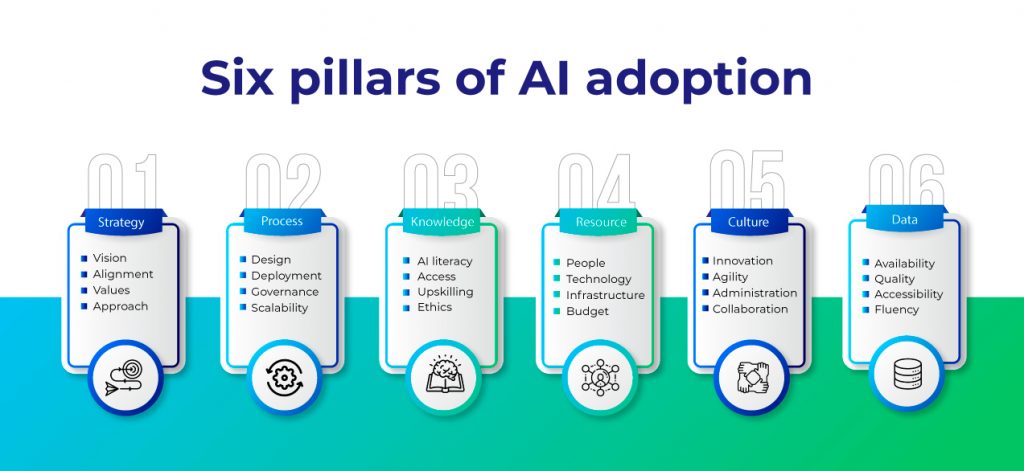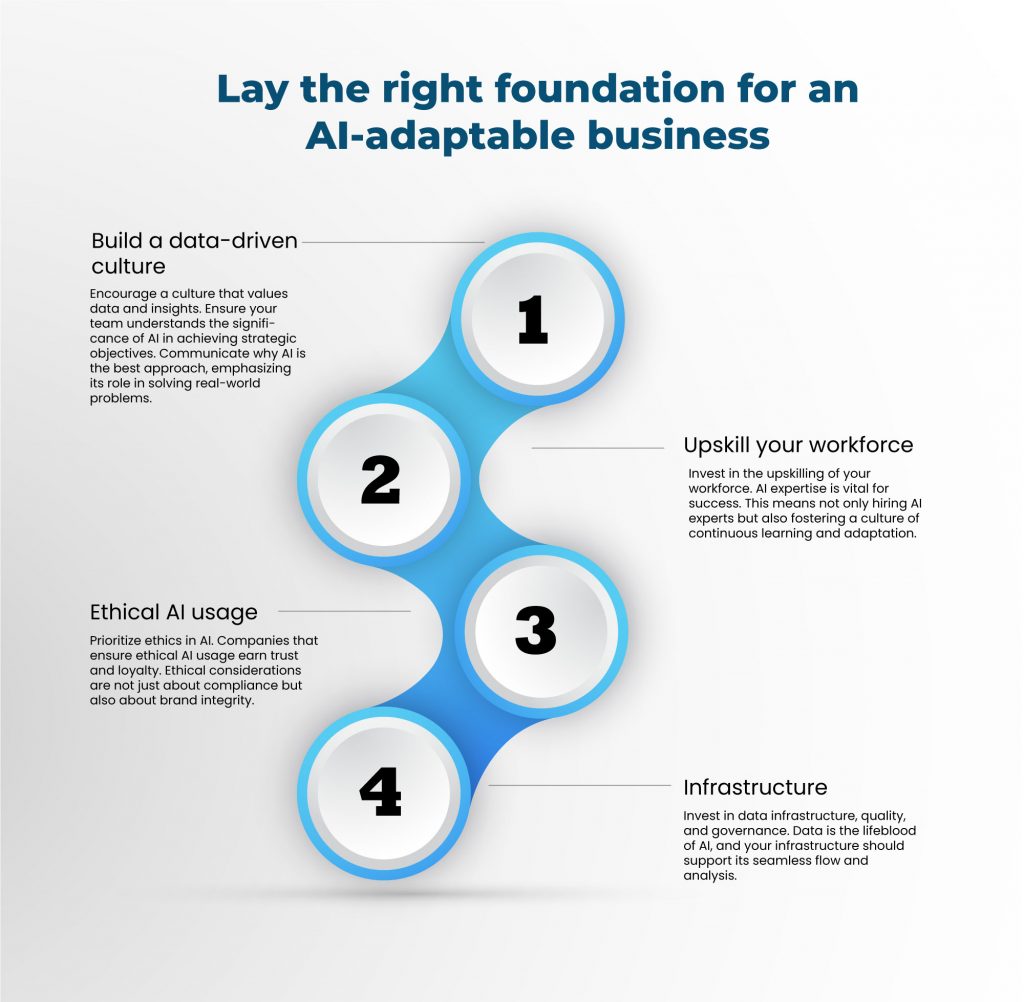
10 Nov 5 Best practices to achieve positive ROI from AI investment
5 Best practices to achieve positive ROI from AI investment
AI serves as a powerful cause for business growth, offering speed, consistency, scalability and most importantly Return of Investment. Companies that embrace AI at scale report a remarkable threefold return on their investments, setting them apart from those still confined to the pilot stage. It’s no surprise that 84% of C-suite executives perceive AI as a vital instrument in achieving their growth aspirations. And, if you are new to implementing AI into your organization, you need to check if your infrastructure is AI-ready or not. With our AI readiness assessment, identify the shortcomings to create a successful AI adoption roadmap and implementation strategy. To assess click!
Understanding different types of AI Investments:
AI is no longer an optional tool; it’s a necessity for businesses aiming to thrive in the digital age. Here’s why AI adoption is crucial for business growth:
-
- Data Investment:
The availability, permissibility, quality and accessibility of labeled data are critical factors in building your machine-learning models. Be careful not to underestimate data challenges. - Technology investments:
To develop and deploy AI models, companies need to invest in both hardware and software infrastructure. - Cybersecurity investments:
Companies need to invest in robust cybersecurity measures to protect their AI systems and the sensitive data they handle. - Responsible AI:
It involves building designing AI models and algorithms that consider their societal impact, adhere to fairness principles, and ensure transparency. - Experimentation:
Businesses should invest in experimentation, allowing data scientists and AI experts to explore various models and approaches.
- Data Investment:

5 Best Practices for Maximizing ROI from AI Investments
We’ve outlined five best practices that should be at the core of your AI strategy.
-
Defining business cases by prioritizing use cases
It is crucial to align AI initiatives with your strategic business objectives. Start by defining your strategic and operational goals in specific, measurable, achievable, realistic, and time-bound (SMART) terms.
Next, break down these objectives into actionable business use cases. These use cases are the building blocks of your AI strategy. For instance, if your goal is to improve customer satisfaction, a use case might involve identifying clients at risk of leaving your service and proactively engaging with them. Prioritize these use cases based on their potential return on investment (ROI), time to implement, and complexity. By involving stakeholders from various departments, you ensure alignment with your strategic objectives and gain early buy-in, setting the stage for a successful AI implementation. -
Quantifying ROI – measuring the AI performance
The success of AI projects hinges on effective measurement. Implement robust performance metrics to assess your AI initiatives continually. These metrics should align with your strategic objectives and KPIs. When building your AI models for your business, start with a proof of concept (POC) to confirm your approach. This POC will help you validate whether you have the right data, predictors, and analytical models to predict the desired outcomes. Once the POC is successful, build and train your analytics model.
Setting KPIs for AI investments: Key Performance Indicators (KPIs) are vital for tracking the progress and success of your AI initiatives. Define KPIs that are directly tied to your strategic objectives. Assign ownership of these KPIs to various departments and teams that can influence them. This accountability ensures that the insights derived from AI models translate into action. After all, the real value of AI lies in its ability to drive systemic change.
Laying the foundation
Companies with a strong data culture are three times more likely to succeed in their AI initiatives. Here’s how you can lay a solid foundation:

Use and acquire right data for AI implementations
Data quality is the cornerstone of successful AI implementations. Start by gathering all relevant data, whether it’s within your organizational systems, hidden in various formats, or publicly available. Ensure that data is cleaned, transformed, and catalogued effectively. Remember, “garbage in, garbage out.”
Use POCs to identify systemic changes required to improve data quality continually. Minor process adjustments can lead to valuable new information. A focus on data quality throughout your AI journey is essential for long-term success.
Strategic scaling
Scaling AI is where the real benefits unfold. Begin with modest investments in specific AI use cases. These smaller steps can generate substantial returns, potentially increasing revenue by up to 6%. As you gain confidence and experience, ramp up your AI investments. The revenue impact of AI can triple to 20% or more as you expand your AI initiatives. Leading companies that scale AI outperform in EBIT and other KPIs, making scaling a critical part of your strategy.
Building successful implementation strategies
Understand your business goal and define the areas that need automation; understand:
-
- The barriers
- Prevailing technology
- Flexible areas of innovation, and
- Resources available
With this, it is likely to have an idea where AI could improve things – but try focusing on the top priorities first by considering the areas that will:
-
- Reduce costs and increase profits
- Launch more data-driven processes
- Improve interaction with customers and employees
Partnering with Nuvento to maximize ROI on AI Investments
Making AI investments count requires a strategic approach. At Nuvento, we specialize in enhancing AI adoption and ensuring you get the decent returns on your investment. Here’s how we can help you maximize your ROI on AI investments:
Business challenge identification:
Our experts work with you to identify your specific business challenges that AI can address. We focus on setting clear objectives, prioritizing use cases, and establishing measurable success criteria. This initial step ensures a well-defined roadmap for implementation.
Data availability:
We assist in assessing the availability of relevant data for AI model development. If data is insufficient, we help you create a plan to collect necessary information. Leveraging third-party data sources is also explored to support your AI initiatives.
Data preparation and feature engineering:
We emphasize the importance of data quality and creative feature engineering. We help you incorporate existing knowledge, such as known fraud patterns, enhances model effectiveness.
Modelling approach selection:
Nuvento guides you in selecting the most appropriate AI algorithms, focusing on simplicity and explainability. For regulated industries, we ensure the chosen model can provide understandable explanations for its decisions.
Operationalization strategy:
Nuvento helps you integrate AI solutions seamlessly into your daily operations. We define how AI insights fit into your workflow, whether they replace manual processes or assist decision-making.
Phased implementation:
Our phased approach ensures a smooth transition. We recommend a pilot phase, allowing AI solutions to run alongside existing processes. This helps teams adjust and gain confidence in the new system.
Training and skill development:
We support building AI expertise within your organization. We assess existing skills and provide training where needed. If skill gaps exist, we help bridge them through training and by bringing in new resources.
Conclusion
AI investments aren’t just about technology; they’re about reshaping your organization’s culture and operations. With the right approach, you can unlock the full potential of AI and secure significant returns for your business.
Ready to maximize your ROI from AI investments? Start by conducting an AI assessment to chart your path to success. An AI assessment can evaluate your organization’s current capabilities, identify gaps, and provide a roadmap for AI adoption. We thoroughly evaluate your organization across the six critical pillars. This uncovers gaps, unlocks your AI potential, and redefines the path to success. By understanding your AI readiness and following a well-crafted roadmap, you can stay in business. Don’t hesitate. Take the AI readiness assessment today:
